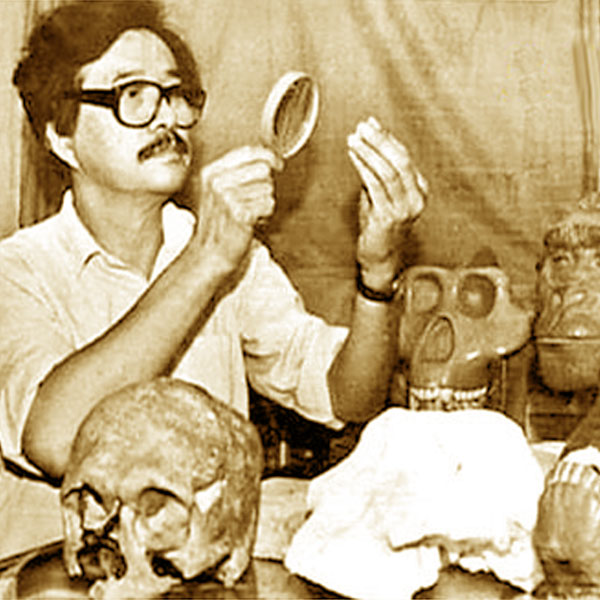 COM.on C.A.5:e14/77-96
Online published on
Nov.16, 2011.
COM.on C.A.5:e14/77-96
Online published on
Nov.16, 2011.doi:10.4236/coca.2011.51014
 COM.on C.A.5:e14/77-96
Online published on
Nov.16, 2011.
COM.on C.A.5:e14/77-96
Online published on
Nov.16, 2011.Guoxing Zhou
Beijing Museum of Natural History, Beijing 100050 China; Nantong Museum, Nantong, Jiangsu 226001 China
Key words: ZHOU Guoxing, Paleoanthropology, Yuanmou Man, Wild Man, Natural History Museum
Recieved: Nov.9, 2011 Accepted: Nov.14, 2011 Corresponding: yuanren924@yahoo.com.cn
《现代人类学通讯》第五卷e14篇 第77-96页 2011年11月16日网上发行
特约综述
2011年人类学终身成就奖获得者-周国兴先生的人类学生涯回顾
周国兴
北京自然博物馆,北京100050; 南通博物苑,江苏 南通226001
摘要:今年的人类学终身成就奖颁给周国兴先生,以表彰他在古人类学领域作出的杰出贡献。周国兴1937年9月出生于江苏省南通市。在故乡度过了他的中小学时代,1957年进上海复旦大学师从人类学家吴定良教授专修体质人类学,1962年毕业后受聘于中国科学院古脊椎动物与古人类研究所,从事古人类学与史前考古学研究,1979年转北京自然博物馆从事人类学与博物馆研究至今,其间1985—1992年任该馆副馆长负责业务领导工作。周还兼任柳州白莲洞洞穴科学博物馆馆长、江苏南通博物苑名誉苑长和上海复旦大学文博学院兼职教授等职。曾任中国自然科学博物馆协会副理事长、中国博物馆学会、北京市博物馆学会等常务理事及多个学会理事之职。 周在长达50年的古人类学和史前考古学研究中成绩斐然,并极有建树:对于中国史前文化的起源,主张“多源论”,在学术上最早正式提出了“长江流域亦是中华古文明摇篮”的论点。在对元谋人化石的详尽研究及在元谋盆地长期考察所获丰富资料和科学论证基础上,他将中国历史的开端坚实地推前到距今170万年以前。他的元谋人及其文化研究获得了北京市科技成果奖和地矿部科技成果一等奖。多次登上帕米尔高原研究我国新疆境内的塔吉克族,论证了他们是我国境内唯一的白色人种原住代表,是古雅利安人的后代。他在塔什库尔干河东岸发现了吉日尕拉史前遗址,具有重要价值。上世纪80年代起,他通过对柳州白莲洞史前遗址的详尽研究,建立了“白莲洞文化系列”的模式,证实了华南中石器时代的真实存在,引起国内外学术界的注目。他在河南许昌和云南元谋发现了两个中石器时代的重要遗址:灵井遗址和大那乌遗址。在人类起源理论研究上提出“劳动”是人类特有的“适应手段”,有高、初两级形态,在从猿到人转变过程中初级形式的劳动具有不可忽视的推动作用,但高级形态劳动却为人类所创造,而且在这转变过程中人类祖先的智力和性因素具有强大作用。1966年他参与并主持了山西大同煤矿煤峪口万人坑的清理与研究工作,他对200具死难矿工所作的人类学研究成果,成为清算日本军国主义者侵华罪行的有力证据。2002年,鉴于他在“促进旧石器考古学、古人类学和第四纪哺乳动物学科所作的贡献”,获得“裴文中科学奖”。 在博物馆学的研究与实践中,经他倡议与参与,筹建了9座博物馆,如柳州白莲洞洞穴科学博物馆、元谋人陈列馆和南通纺织博物馆,在推动北京自然博物馆的发展与复兴南通博物苑方面,他都作了重要贡献。在科学知识普及工作上,他也取得丰硕成果,他发表了大量的科普作品,举办过多次科普展览,经中国科普作协第三次、第四次全国代表大会审定,为“成绩突出的科普作家”。1996年被授予“北京市先进科普工作者”称号。至今周已发表出版20部科学专著与科普作品集,不少作品获得奖励。他的1988年《人之由来》展,获得很高的国际声誉,其画册获得“第三届全国科普优秀作品一等奖”。周被列入国内外许多名人录中,英国剑桥国际传记中心将他列入当今领先人物500之列,并授予他金质奖章和“20世纪杰出人物”荣誉称号。2010年7月5日更将他列为该中心创建以来拔尖人物200名之列。1989年被美国国际传记研究所授予“杰出领导人物奖”和“近四分之一世纪500名最有影响人物之一”的荣誉称号。鉴于他在我国科学研究事业中的杰出贡献,1996年被授予国家特殊津贴,也就是说他被认为是国家级有特殊贡献的专家。
关键词:周国兴;古人类学;元谋人;野人;自然博物馆
收稿日期:2011年11月8日
修回日期:2011年11月14日
联系人:周国兴
yuanren924@yahoo.com.cn
1. 周国兴等(1972)北京东胡林村的新石器时代墓葬. 考古 (6).
2. 周国兴(1974)河南许昌灵井石器时代遗存. 考古 (2).
3. 周国兴(1977)人类起源内因初探. 古脊椎动物与古人类 15(3).
4. 周国兴(云博) (1977)云南丽江人头骨的初步研究. 古脊椎动物与古人类 15(2).
5. 周国兴等(1978)云南元谋人化石产地的综合研究. 古人类论文集.
6. 周国兴(1979)对元谋人认识的探讨. 自然杂志 (2).
7. 周国兴等(1979)元谋人牙齿化石再研究. 古脊椎动物与古人类 17(2).
8. 周国兴等(1980)云南元谋早更新世动物群的进一步划分. 北京自然博物馆研究报告 4 .
9. 周国兴等(1980)云南元谋盆地的细石器遗存. 北京自然博物馆研究报告 5.
10. 周国兴等(1981)云南禄丰含古猿化石群上新统地层, 附录:新发现两件古猿颌骨的初步观察. 北京自然博物馆研究报告 10.
11. 周国兴等(1982)广西柳州地区岩溶群古人类化石的初步研究. 北京自然博物馆研究报告 20.
12. 周国兴(1982)湖北房县古人类活动遗迹的初步调查报告. 考古与文物 (3).
13. Zhou Guoxing(1982)The status of wildman research in China. Cryptozoology 1:13-23 .
14. 周国兴等(1983)三探柳江人洞. 大自然 (4).
15. 周国兴(1984)中国的野人. 宇宙探索. 科普出版社广州分社.
16. 周国兴等(1984)元谋人化石产地发掘报告. 元谋人.
17. 周国兴(1984)云南德钦纳古石棺墓的人骨. 北京自然博物馆研究报告 28.
18. 周国兴(1984)白莲洞遗址的发现及其意义. 史前研究 (2) .
19. Zhou Guoxing(1984)Morphological analysis(wildman) hand and foot specimens. Cryptozoology 3:58-70 .
20. 周国兴(1983)长江流域-中华民族远古文明的又一摇篮. 史前研究.
21. 周国兴(1985)新疆塔什库尔干吉日尕拉遗址. 新疆文物考古 (创刊号).
22. 周国兴等(1985)原始挖土棒上的穿孔重石. 农史研究 (5) .
23. 周国兴(1986)白莲洞文化一一兼论华南地区的中石器时代. 北京自然博物馆研究报告 40(“纪念北京自然博物馆建馆卅五周年”刋).
24. Zhou Guoxing(1988)The first man in China: the date and environment of Yuanmou Man, The palaeoenvironment of East Asia from the mid-Tertiary. Processings of second conference 2: 1062-1068.
25. Zhou Guoxing(1988)Distribution and extinction of the early orangutan in South China. A collection of these for the “First international conference on Wildlife Conservation, China'87”. Hongkong (中国南方早期猩猩的分布与绝灭. 载《第一届国际野生动物保护会议文集》. 1988,香港).
26. 周国兴,白莲洞文化与华南中石器时代的探讨(英文)亚洲与环太平洋考古学会论文集.
27. 周国兴等(1988)直立人演化地位的探讨. 杭州师范学院学报(自然科学) (6).
28. 周国兴等(1990)蓝田人的进一步研究. 考察与研究(上海自然博物馆) (1) .
29. 周国兴等(1990)北京丰台地区新发现的一件人枕骨化石的硏究. 杭州师范学院学报(自然科学) (6) .
30. 周国兴等(1991)山西“丁村人”生活时期周围自然环境. 北京自然博物馆研究报告 48.
31. 周国兴等(1992)元谋人胫骨化石研究. 北京人笫一头盖骨发现六十周年文集.
32. 周国兴(1992)是劳动创造人,还是人创造了劳动? 北京人第一头盖骨发现六十周年文集.
33. 周国兴(1993)白莲洞文化 中国南方中石器文化的检讨. 日本别府大学公开讲座.
34. 周国兴(1994)再论白莲洞文化. 中日古人类与史前文化渊源关系国际学术研讨会论文集. 中国国际广播出版社 p.203-264.
35. 周国兴等(1994)大龙潭人骨的硏究-兼谈港川人与华南地区更新世晚期一一全新世早期古人类的关系. 中日古人类与史前文化渊源关系国际学术研讨会论文集. p.59-81.
36. 周国兴等(1994)白莲洞遗址的发现、硏究与新进展.中日古人类与史前文化渊源关系国际学术研讨会论文集. p.147-155.
37. 周国兴(1994)中国古人类学研究的历史与现状. 史学论丛 24. 别府大学史学研究会.
38. 周国兴等(1994)自然保护区保护与利用的评估. 北京自然博物馆研究报告 54:151-161.
39. 周国兴(1997) “东方人”和“蝴蝶人”石器的质疑-兼对“蝴蝶拉玛猿”头骨属性的探讨. 北京自然博物馆研究报告 56 :231-251. Discussion on Stone Implements of the “Oriental Man” and “Butterfly Ridge Man” with on the Attributes of the Cranium of “Ramapithecus hudienesis”. Memoirs of Beijing Natural History Museum 56.
40. 周国兴(1997)元谋盆地人类文化遗存的硏究. 元谋古猿. 云南科技出版社,p.197-202 .
41. 周国兴(1998)元谋盆地人类化石与文化遗存的研究. “元谋人”发现三十周年纪念暨古人类国际学术研讨会文集. p.18-32 .
42. Zhou Guoxing(1998)A Study of Fossil Hominid and Culture Remains in Yuanmou Basin. Collected works for“the 30th anniversary of Yuanmou Man discovery and the international conference on palaeoanthropological studies”. p.303-227.
43. 周国兴(1999)追踪野人40年. 中国国家地理 (8). The History and Recent Status of Wildman Research in China. Chinese National Geography (8).
44. 周国兴(1999)元谋古猿幼年头骨的再研究-兼对“巫山人”属性的探讨. 北京自然博物馆研究报告 58:111-123. Suppementary Notes on the Baby Skull of Sivapithecus yunnanesis with Discussions on“Wushan Man”. Memors of Beijing Natural History Museum 58.
45. 周国兴(1999)白莲洞文化与华南中石器时代(英文). 中石器时代及有关问题研讨会论集. 广东人民出版社 p.44.
46. Zhou Guoxing(1999)On Bailiandong Culture.Treatises of international conference on mesolithic culture. People's Publishing House of Guangdong. p.27-43.
47. 周国兴(2000)人类起源大搜索. 中国国家地理 (10). Great search of human origins. Chinese National Geography (10).
48. 周国兴(2001)中国古人类硏究的历史与现状. 北京自然博物馆研究报告 59:65-81.
49. 周国兴(2001)中国古人类学一百年.(One century of China' palaeoanthropology studies-history,pesent situation and prospect)
50. 周国兴(2002)华南早期褐猿的分布与演化. 北京自然博物馆研究报告 60 :74-87.
51. 周国兴(2002)三论白莲洞文化-对同期遗址研究新进展的思考. 史前硏究. 三秦出版社p.91-102.
52. 周国兴(2004)人类起源硏究的新进展与我国的现状. 史前硏究. 三秦出版社p.23-61.
53. 周国兴(2004)人乎?猿乎?-最早人类化石硏究综述硏究综述. 人类学学报 23(纪念裴文中教授百年诞辰论文集增刊):78-91.
54. 周国兴(2007)石器时代的万能工具-穿孔砾石或穿孔石(重石). 农业考古 (1):127-147.